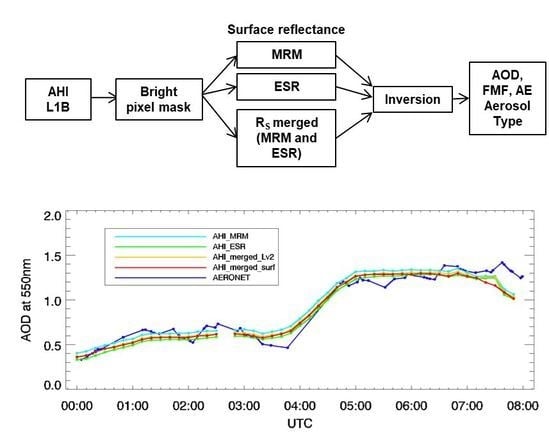AHI/Himawari-8 Yonsei Aerosol Retrieval (YAER): Algorithm, Validation and Merged Products
Abstract
1. Introduction
2. Development of the AHI YAER Algorithm
2.1. Cloud and Bright-Surface Masking
2.2. Determination of Land Surface Reflectance
2.2.1. Minimum Reflectance Method (MRM)
2.2.2. SWIR (ESR) Estimates
2.3. Determination of Ocean Surface Reflectance
2.4. Inversion Process
3. Retrieval and Validation Results
3.1. Retrieval Results from AHI YAER Products
3.2. Validation of AOD and AE
3.3. Error Analysis
3.3.1. Analysis of Two Land Products
3.3.2. Analysis of Two Ocean Products
4. AHI YAER Merged Aerosol Products
5. Conclusions
Author Contributions
Acknowledgments
Conflicts of Interest
References
- Lau, K.M.; Kim, K.M. Observational relationships between aerosol and Asian monsoon rainfall, and circulation. Geophys. Res. Lett. 2006, 33. [Google Scholar] [CrossRef]
- Stocker, T.F.; Qin, D.; Plattner, G.-K.; Tignor, M.M.; Allen, S.K.; Boschung, J.; Nauels, A.; Xia, Y.; Bex, V.; Midgley, P.M. Climate Change 2013: The Physical Science Basis. Contribution of Working Group I to the Fifth Assessment Report of IPCC the Intergovernmental Panel on Climate Change; Cambridge University Press: Cambridge, UK, 2014. [Google Scholar]
- Harrison, R.M.; Yin, J. Particulate matter in the atmosphere: Which particle properties are important for its effects on health? Sci. Total Environ. 2000, 249, 85–101. [Google Scholar] [CrossRef]
- Lim, S.S.; Vos, T.; Flaxman, A.D.; Danaei, G.; Shibuya, K.; Adair-Rohani, H.; AlMazroa, M.A.; Amann, M.; Anderson, H.R.; Andrews, K.G.; et al. A comparative risk assessment of burden of disease and injury attributable to 67 risk factors and risk factor clusters in 21 regions, 1990–2010: A systematic analysis for the global burden of disease study 2010. Lancet 2012, 380, 2224–2260. [Google Scholar] [CrossRef]
- Remer, L.A.; Kaufman, Y.; Tanré, D.; Mattoo, S.; Chu, D.; Martins, J.V.; Li, R.-R.; Ichoku, C.; Levy, R.; Kleidman, R. The MODIS aerosol algorithm, products, and validation. J. Atmos. Sci. 2005, 62, 947–973. [Google Scholar] [CrossRef]
- Levy, R.C.; Remer, L.A.; Mattoo, S.; Vermote, E.F.; Kaufman, Y.J. Second-generation operational algorithm: Retrieval of aerosol properties over land from inversion of Moderate Resolution Imaging Spectroradiometer spectral reflectance. J. Geophys. Res. 2007, 112, D13211. [Google Scholar] [CrossRef]
- Levy, R.C.; Remer, L.A.; Kleidman, R.G.; Mattoo, S.; Ichoku, C.; Kahn, R.; Eck, T.F. Global evaluation of the collection 5 MODIS dark-target aerosol products over land. Atmos. Chem. Phys. 2010, 10, 10399–10420. [Google Scholar] [CrossRef]
- Levy, R.; Mattoo, S.; Munchak, L.; Remer, L.; Sayer, A.; Hsu, N. The collection 6 MODIS aerosol products over land and ocean. Atmos. Meas. Tech. 2013, 6, 159–259. [Google Scholar] [CrossRef]
- Hsu, N.C.; Tsay, S.-C.; King, M.D.; Herman, J.R. Aerosol properties over bright-reflecting source regions. IEEE Trans. Geosci. Remote Sens. 2004, 42, 557–569. [Google Scholar] [CrossRef]
- Hsu, N.C.; Tsay, S.-C.; King, M.D.; Herman, J.R. Deep blue retrievals of Asian aerosol properties during Ace-Asia. IEEE Trans. Geosci. Remote Sens. 2006, 44, 3180–3195. [Google Scholar] [CrossRef]
- Hsu, N.C.; Jeong, M.J.; Bettenhausen, C.; Sayer, A.M.; Hansell, R.; Seftor, C.S.; Huang, J.; Tsay, S.C. Enhanced Deep Blue aerosol retrieval algorithm: The second generation. J. Geophys. Res. 2013, 118, 9296–9315. [Google Scholar] [CrossRef]
- Kalashnikova, O.V.; Garay, M.J.; Martonchik, J.V.; Diner, D.J. MISR Dark Water aerosol retrievals: Operational algorithm sensitivity to particle non-sphericity. Atmos. Meas. Tech. 2013, 6, 2131–2154. [Google Scholar] [CrossRef]
- Martonchik, J.V.; Kahn, R.A.; Diner, D.J. Retrieval of aerosol properties over land using MISR observations. In Satellite Aerosol Remote Sensing Over Land; Springer: Berlin/Heidelberg, Germany, 2009; pp. 267–293. [Google Scholar]
- Garay, M.J.; Kalashnikova, O.V.; Bull, M.A. Development and assessment of a higher-spatial-resolution (4.4 km) MISR aerosol optical depth product using AERONET-DRAGON data. Atmos. Chem. Phys. 2017, 17, 5095–5106. [Google Scholar] [CrossRef]
- Dubovik, O.; Herman, M.; Holdak, A.; Lapyonok, T.; Tanré, D.; Deuzé, J.L.; Ducos, F.; Sinyuk, A.; Lopatin, A. Statistically optimized inversion algorithm for enhanced retrieval of aerosol properties from spectral multi-angle polarimetric satellite observations. Atmos. Meas. Tech. 2011, 4, 975–1018. [Google Scholar] [CrossRef]
- Kim, J.; Yoon, J.M.; Ahn, M.; Sohn, B.; Lim, H. Retrieving aerosol optical depth using visible and mid-IR channels from geostationary satellite MTSAT-1R. Int. J. Remote Sens. 2008, 29, 6181–6192. [Google Scholar] [CrossRef]
- Yoon, J.M.; Kim, J.; Lee, J.H.; Cho, H.K.; Sohn, B.-J.; Ahn, M.-H. Retrieval of aerosol optical depth over East Asia from a geostationary satellite, MTSAT-1R. Asia Pac. J. Atmos. Sci. 2007, 43, 49–58. [Google Scholar]
- Bernard, E.; Moulin, C.; Ramon, D.; Jolivet, D.; Riedi, J.; Nicolas, J.M. Description and validation of an AOT product over land at the 0.6 μm channel of the SEVIRI sensor onboard MSG. Atmos. Meas. Tech. 2011, 4, 2543–2565. [Google Scholar] [CrossRef]
- Knapp, K.; Frouin, R.; Kondragunta, S.; Prados, A. Toward aerosol optical depth retrievals over land from GOES visible radiances: Determining surface reflectance. Int. J. Remote Sens. 2005, 26, 4097–4116. [Google Scholar] [CrossRef]
- Wang, J. Geostationary satellite retrievals of aerosol optical thickness during Ace-Asia. J. Geophys. Res. 2003, 108. [Google Scholar] [CrossRef]
- Kim, M.; Kim, J.; Wong, M.S.; Yoon, J.; Lee, J.; Wu, D.; Chan, P.; Nichol, J.E.; Chung, C.-Y.; Ou, M.-L. Improvement of aerosol optical depth retrieval over Hong Kong from a geostationary meteorological satellite using critical reflectance with background optical depth correction. Remote Sens. Environ. 2014, 142, 176–187. [Google Scholar] [CrossRef]
- Kim, M.; Kim, J.; Jeong, U.; Kim, W.; Hong, H.; Holben, B.; Eck, T.F.; Lim, J.H.; Song, C.K.; Lee, S.; et al. Aerosol optical properties derived from the DRAGON-NE Asia campaign, and implications for a single-channel algorithm to retrieve aerosol optical depth in spring from Meteorological Imager (MI) on-board the Communication, Ocean, and Meteorological Satellite (COMS). Atmos. Chem. Phys. 2016, 16, 1789–1808. [Google Scholar]
- Choi, M.; Kim, J.; Lee, J.; Kim, M.; Park, Y.-J.; Jeong, U.; Kim, W.; Hong, H.; Holben, B.; Eck, T.F.; et al. GOCI Yonsei Aerosol Retrieval (YAER) algorithm and validation during the DRAGON-NE Asia 2012 campaign. Atmos. Meas. Tech. 2016, 9, 1377–1398. [Google Scholar] [CrossRef]
- Choi, M.; Kim, J.; Lee, J.; Kim, M.; Park, Y.-J.; Holben, B.; Eck, T.F.; Li, Z.; Song, C.H. GOCI Yonsei aerosol retrieval version 2 products: An improved algorithm and error analysis with uncertainty estimation from 5-year validation over East Asia. Atmos. Meas. Tech. 2018, 11, 385–408. [Google Scholar] [CrossRef]
- Schmit, T.J.; Gunshor, M.M.; Menzel, W.P.; Gurka, J.J.; Li, J.; Bachmeier, A.S. Introducing the next-generation Advanced baseline imager on GOES-R. Bull. Am. Meteorol. Soc. 2005, 86, 1079–1096. [Google Scholar] [CrossRef]
- Kikuchi, M.; Murakami, H.; Suzuki, K.; Nagao, T.M.; Higurashi, A. Improved Hourly Estimates of Aerosol Optical Thickness Using Spatiotemporal Variability Derived From Himawari-8 Geostationary Satellite. IEEE Trans. Geosci. Remote Sens. 2018, 1–14. [Google Scholar] [CrossRef]
- Lim, H.; Choi, M.; Kim, M.; Kim, J.; Chan, P.W. Retrieval and validation of aerosol optical properties using Japanese next generation meteorological satellite, Himawari-8. Korean J. Remote Sens. 2016, 32, 681–691. [Google Scholar] [CrossRef][Green Version]
- Bessho, K.; Date, K.; Hayashi, M.; Ikeda, A.; Imai, T.; Inoue, H.; Kumagai, Y.; Miyakawa, T.; Murata, H.; Ohno, T.; et al. An introduction to Himawari-8/9—Japan’s New-generation Geostationary Meteorological Satellites. J. Meteorol. Soc. Jpn. 2016, 94, 151–183. [Google Scholar] [CrossRef]
- Iwabuchi, H.; Saito, M.; Tokoro, Y.; Putri, N.S.; Sekiguchi, M. Retrieval of radiative and microphysical properties of clouds from multispectral infrared measurements. Prog. Earth Planet. Sci. 2016, 3, 32. [Google Scholar] [CrossRef]
- Frey, R.A.; Ackerman, S.A.; Liu, Y.; Strabala, K.I.; Zhang, H.; Key, J.R.; Wang, X. Cloud Detection with MODIS. Part I: Improvements in the MODIS Cloud Mask for Collection 5. J. Atmos. Ocean. Technol. 2008, 25, 1057–1072. [Google Scholar] [CrossRef]
- Wang, Y.; Chen, L.; Li, S.; Wang, X.; Yu, C.; Si, Y.; Zhang, Z. Interference of heavy aerosol loading on the VIIRS Aerosol Optical Depth (AOD) Retrieval Algorithm. Remote Sens. 2017, 9, 397. [Google Scholar] [CrossRef]
- Pinty, B.; Verstraete, M. GEMI: A non-linear index to monitor global vegetation from satellites. Plant Ecol. 1992, 101, 15–20. [Google Scholar] [CrossRef]
- Kopp, T.J.; Thomas, W.; Heidinger, A.K.; Botambekov, D.; Frey, R.A.; Hutchison, K.D.; Iisager, B.D.; Brueske, K.; Reed, B. The VIIRS Cloud Mask: Progress in the first year of S-NPP toward a common cloud detection scheme. J. Geophys. Res. 2014, 119, 2441–2456. [Google Scholar] [CrossRef]
- Ishida, H.; Nakajima, T.Y. Development of an unbiased cloud detection algorithm for a Spaceborne multispectral imager. J. Geophys. Res. Atmos. 2009, 114. [Google Scholar] [CrossRef]
- Rong-Rong, L.; Kaufman, Y.J.; Bo-Cai, G.; Davis, C.O. Remote sensing of suspended sediments and shallow coastal waters. IEEE Trans. Geosci. Remote Sens. 2003, 41, 559–566. [Google Scholar] [CrossRef]
- Fukuda, S.; Nakajima, T.; Takenaka, H.; Higurashi, A.; Kikuchi, N.; Nakajima, T.Y.; Ishida, H. New approaches to removing cloud shadows and evaluating the 380 nm surface reflectance for improved aerosol optical thickness retrievals from the GOSAT/TANSO-Cloud and Aerosol Imager. J. Geophys. Res. 2013, 118. [Google Scholar] [CrossRef]
- Wang, Y.; Lyapustin, A.I.; Privette, J.L.; Morisette, J.T.; Holben, B. Atmospheric correction at AERONET locations: A new science and validation data set. IEEE Trans. Geosci. Remote Sens. 2009, 47, 2450–2466. [Google Scholar] [CrossRef]
- Lyapustin, A.; Wang, Y.; Laszlo, I.; Kahn, R.; Korkin, S.; Remer, L.; Levy, R.; Reid, J.S. Multiangle implementation of atmospheric correction (MAIAC): 2. Aerosol algorithm. J. Geophys. Res. 2011, 116, D03211. [Google Scholar] [CrossRef]
- Gupta, P.; Levy, R.C.; Mattoo, S.; Remer, L.A.; Munchak, L.A. A surface reflectance scheme for retrieving aerosol optical depth over urban surfaces in MODIS Dark Target retrieval algorithm. Atmos. Meas. Tech. 2016, 9, 3293–3308. [Google Scholar] [CrossRef]
- Zhong, G.; Wang, X.; Tani, H.; Guo, M.; Chittenden, A.; Yin, S.; Sun, Z.; Matsumura, S. A Modified Aerosol Free Vegetation Index Algorithm for Aerosol Optical Depth Retrieval Using GOSAT TANSO-CAI data. Remote Sens. 2016, 8, 998. [Google Scholar] [CrossRef]
- Lee, J.; Kim, J.; Yang, P.; Hsu, N.C. Improvement of aerosol optical depth retrieval from MODIS spectral reflectance over the global ocean using new aerosol models archived from AERONET inversion data and tri-axial ellipsoidal dust database. Atmos. Chem. Phys. 2012, 12, 7087–7102. [Google Scholar] [CrossRef]
- Friedl, M.A.; Sulla-Menashe, D.; Tan, B.; Schneider, A.; Ramankutty, N.; Sibley, A.; Huang, X. MODIS Collection 5 global land cover: Algorithm Refinements and characterization of new datasets. Remote Sens. Environ. 2010, 114, 168–182. [Google Scholar] [CrossRef]
- Cox, C.; Munk, W. Measurement of the roughness of the sea surface from photographs of the sun’s glitter. J. Opt. Soc. Am. 1954, 44, 838–850. [Google Scholar] [CrossRef]
- Jackson, J.M.; Liu, H.; Laszlo, I.; Kondragunta, S.; Remer, L.A.; Huang, J.; Huang, H.-C. Suomi-NPP VIIRS aerosol algorithms and data products. J. Geophys. Res. 2013, 118, 12673–12689. [Google Scholar] [CrossRef]
- Spurr, R.J.D. VLIDORT: A linearized pseudo-spherical vector discrete ordinate radiative transfer code for forward model and retrieval studies in multilayer multiple scattering media. J. Quant. Spectrosc. Radiat. Transf. 2006, 102, 316–342. [Google Scholar] [CrossRef]
- Kim, J.; Lee, J.; Lee, H.C.; Higurashi, A.; Takemura, T.; Song, C.H. Consistency of the aerosol type classification from satellite remote sensing during the Atmospheric Brown Cloud—East Asia Regional Experiment campaign. J. Geophys. Res. 2007, 112. [Google Scholar] [CrossRef]
- Lee, J.; Kim, J.; Song, C.H.; Kim, S.B.; Chun, Y.; Sohn, B.J.; Holben, B.N. Characteristics of aerosol types from AERONET sunphotometer measurements. Atmos. Environ. 2010, 44, 3110–3117. [Google Scholar] [CrossRef]
- Murakami, H. Ocean color estimation by Himawari-8/AHI. In Proceedings of the SPIE Asia-Pacific Remote Sensing, New Delhi, India, 4–7 April 2016. [Google Scholar]
- Sayer, A.M.; Hsu, N.C.; Bettenhausen, C.; Ahmad, Z.; Holben, B.N.; Smirnov, A.; Thomas, G.E.; Zhang, J. SeaWiFS Ocean Aerosol Retrieval (SOAR): Algorithm, validation, and comparison with other data sets. J. Geophys. Res. 2012, 117. [Google Scholar] [CrossRef]
- Tao, M.; Chen, L.; Wang, Z.; Tao, J.; Che, H.; Wang, X.; Wang, Y. Comparison and evaluation of the MODIS Collection 6 aerosol data in China. J. Geophys. Res. 2015, 120, 6992–7005. [Google Scholar] [CrossRef]
- Yamada, K.; Ishizaka, J.; Yoo, S.; Kim, H.-C.; Chiba, S. Seasonal and interannual variability of sea surface chlorophyll a concentration in the Japan/East Sea (JES). Prog. Oceanogr. 2004, 61, 193–211. [Google Scholar] [CrossRef]
- Bilal, M.; Nichol, J.E.; Wang, L. New customized methods for improvement of the MODIS C6 Dark Target and Deep Blue merged aerosol product. Remote Sens. Environ. 2017, 197, 115–124. [Google Scholar] [CrossRef]
- Sayer, A.M.; Munchak, L.A.; Hsu, N.C.; Levy, R.C.; Bettenhausen, C.; Jeong, M.J. MODIS Collection 6 aerosol products: Comparison between Aqua’s e-Deep Blue, Dark Target, and “merged” data sets, and usage recommendations. J. Geophys. Res. 2014, 119, 965–989. [Google Scholar]
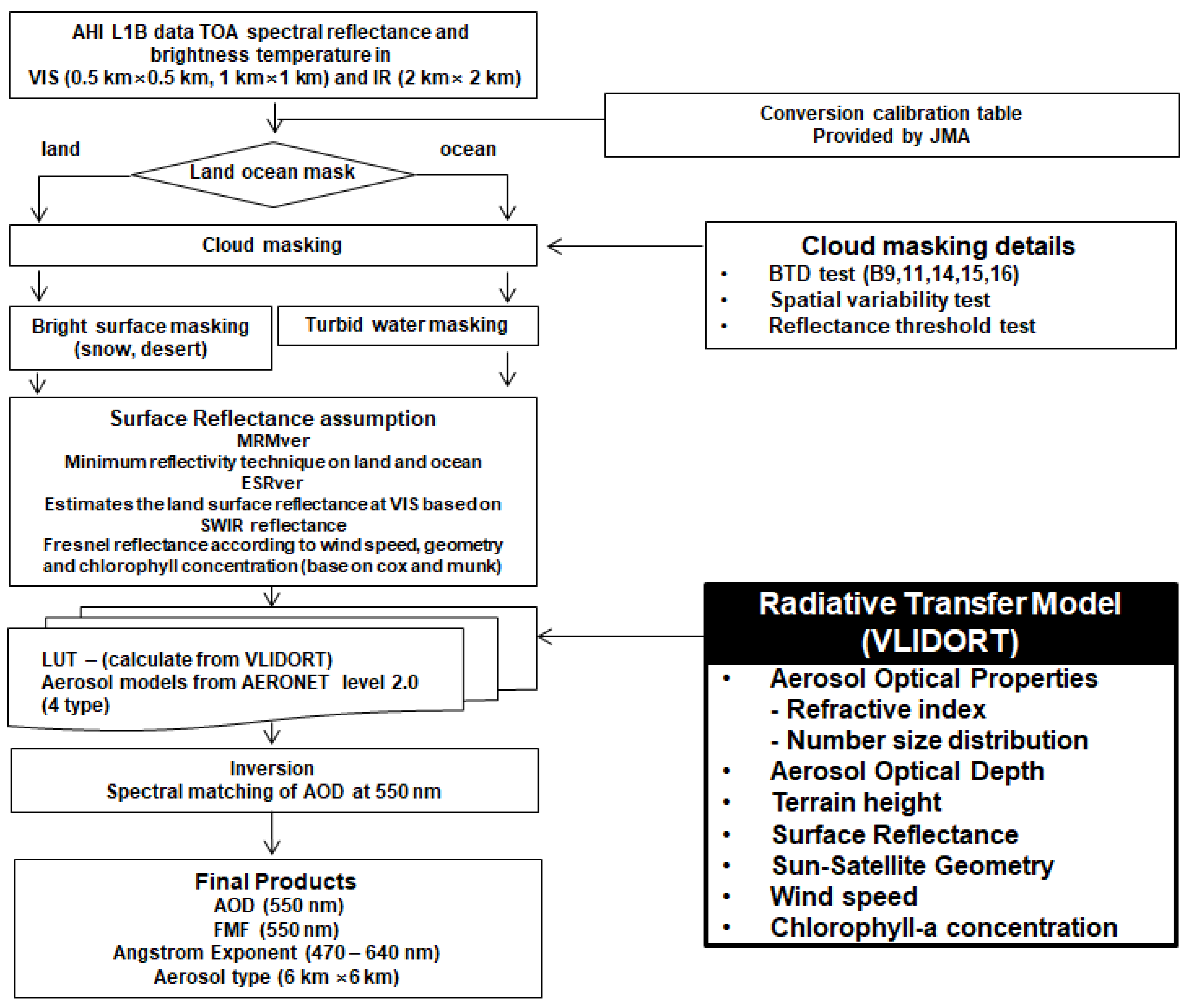
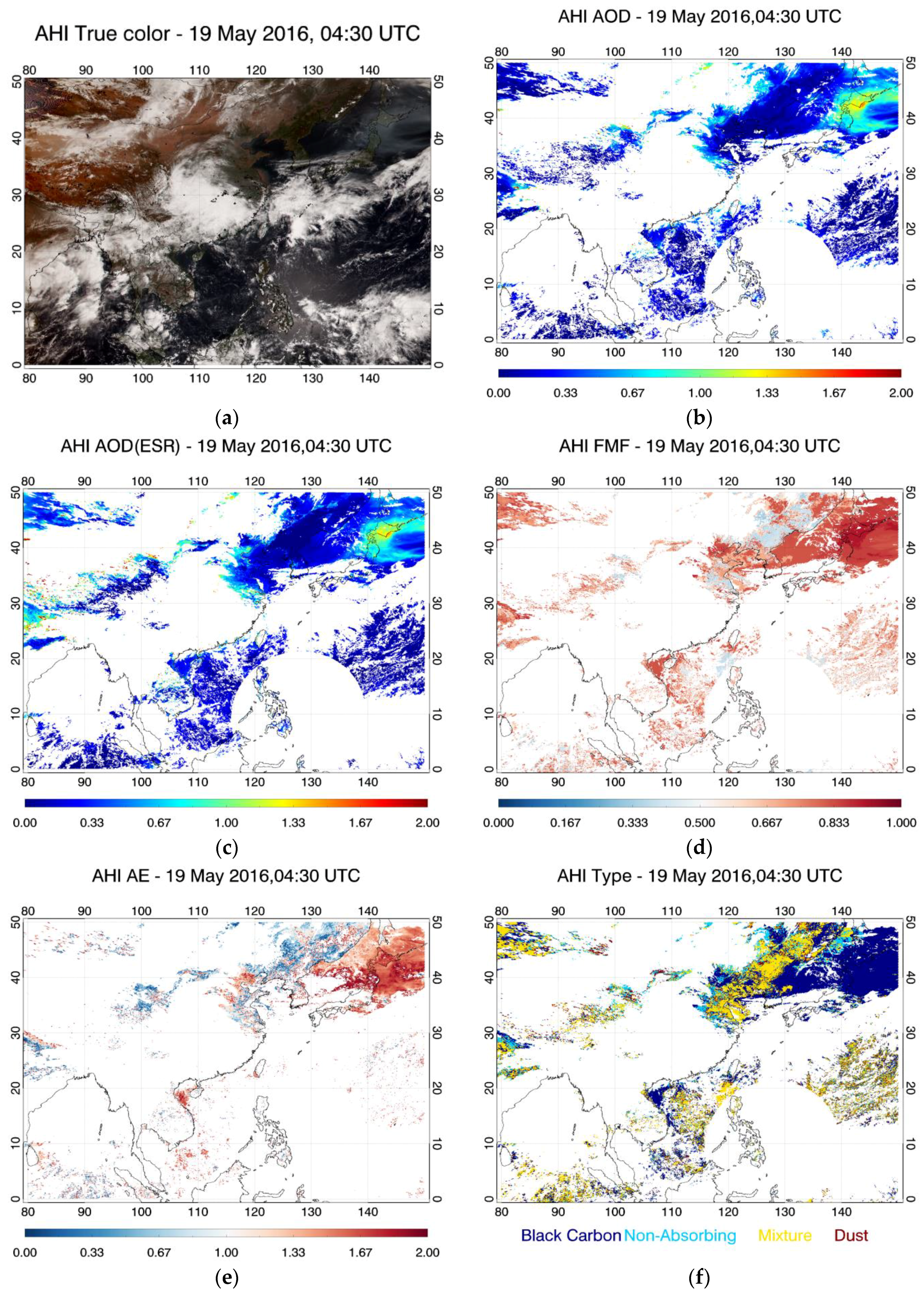

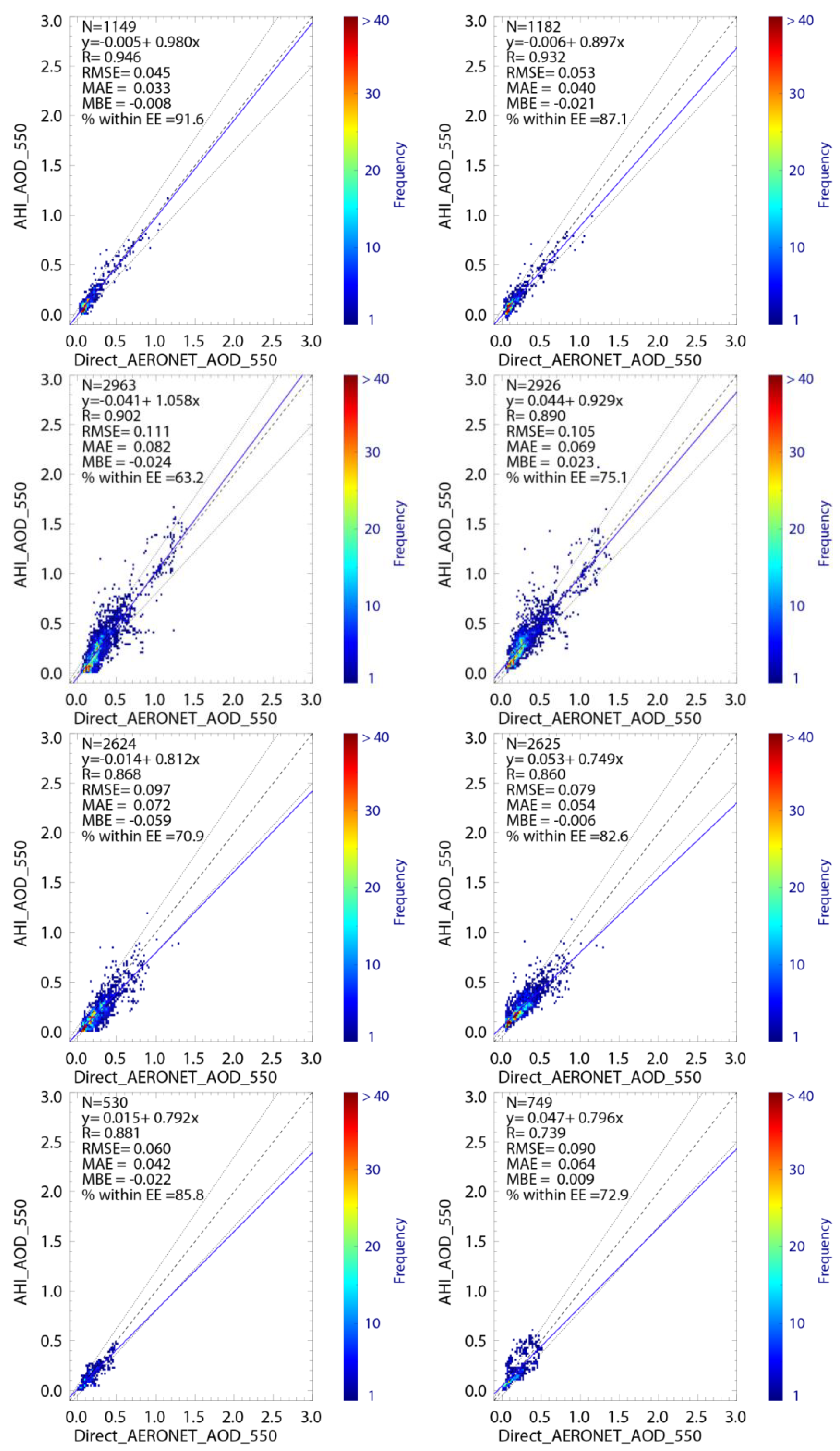

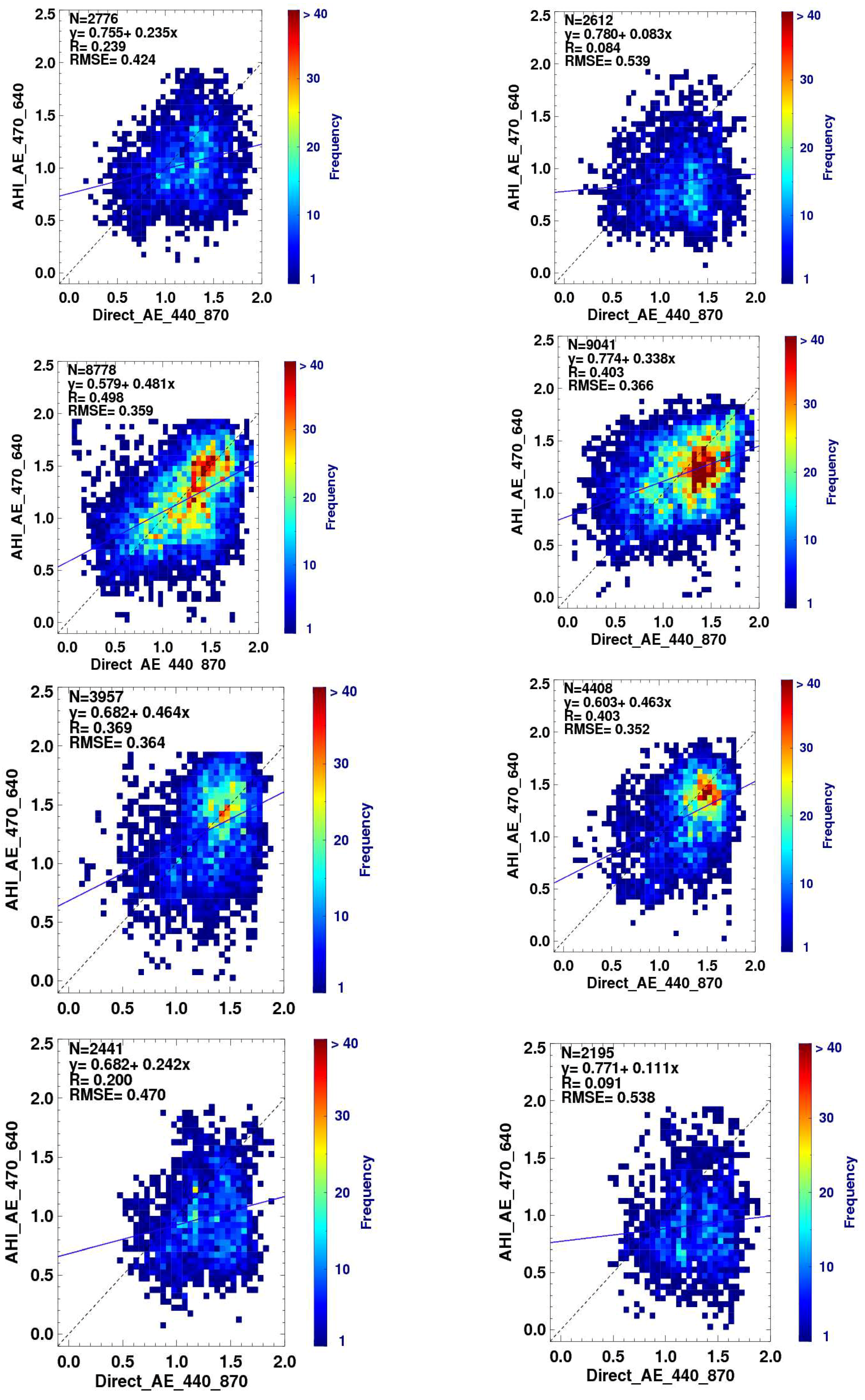

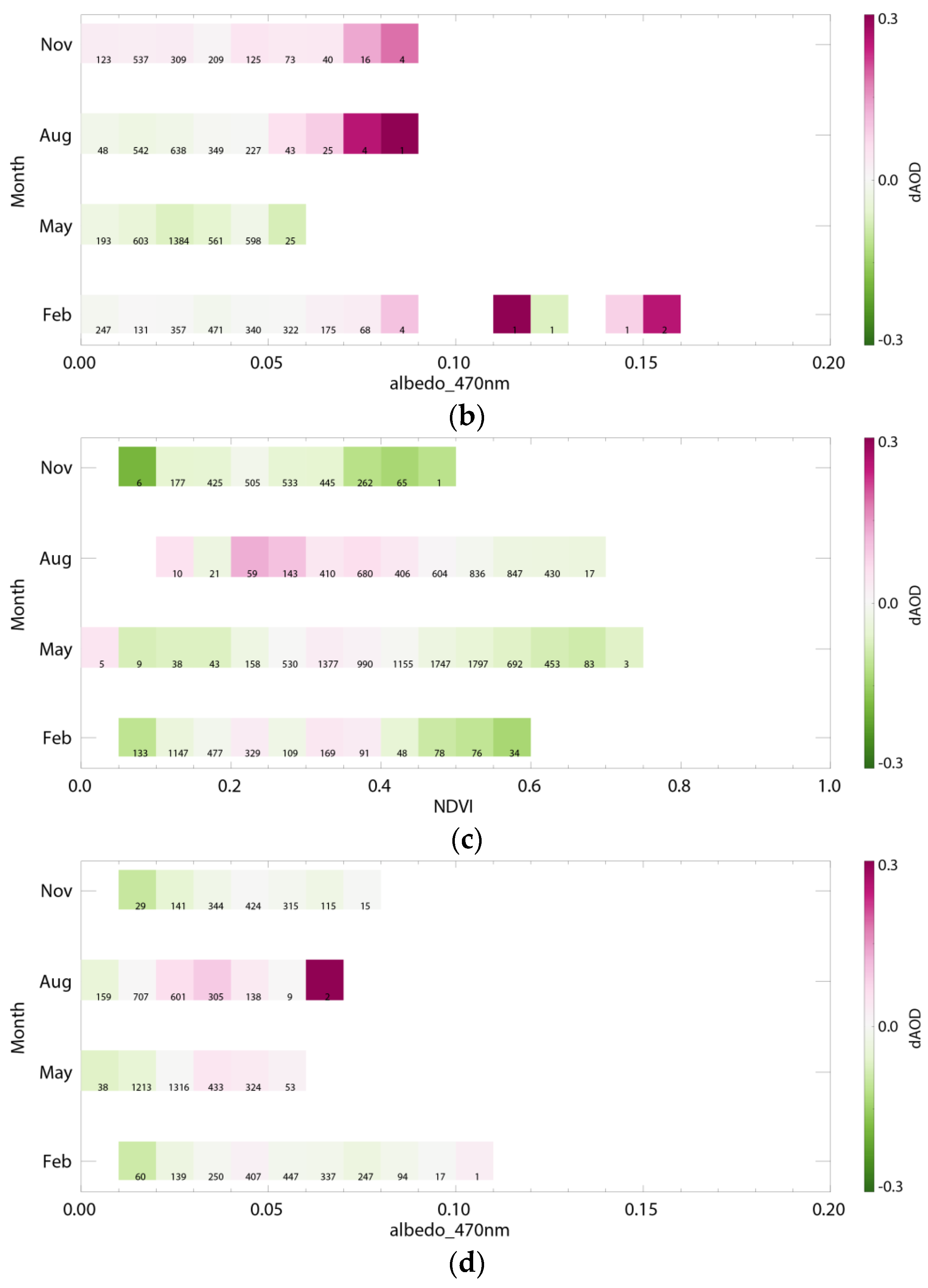
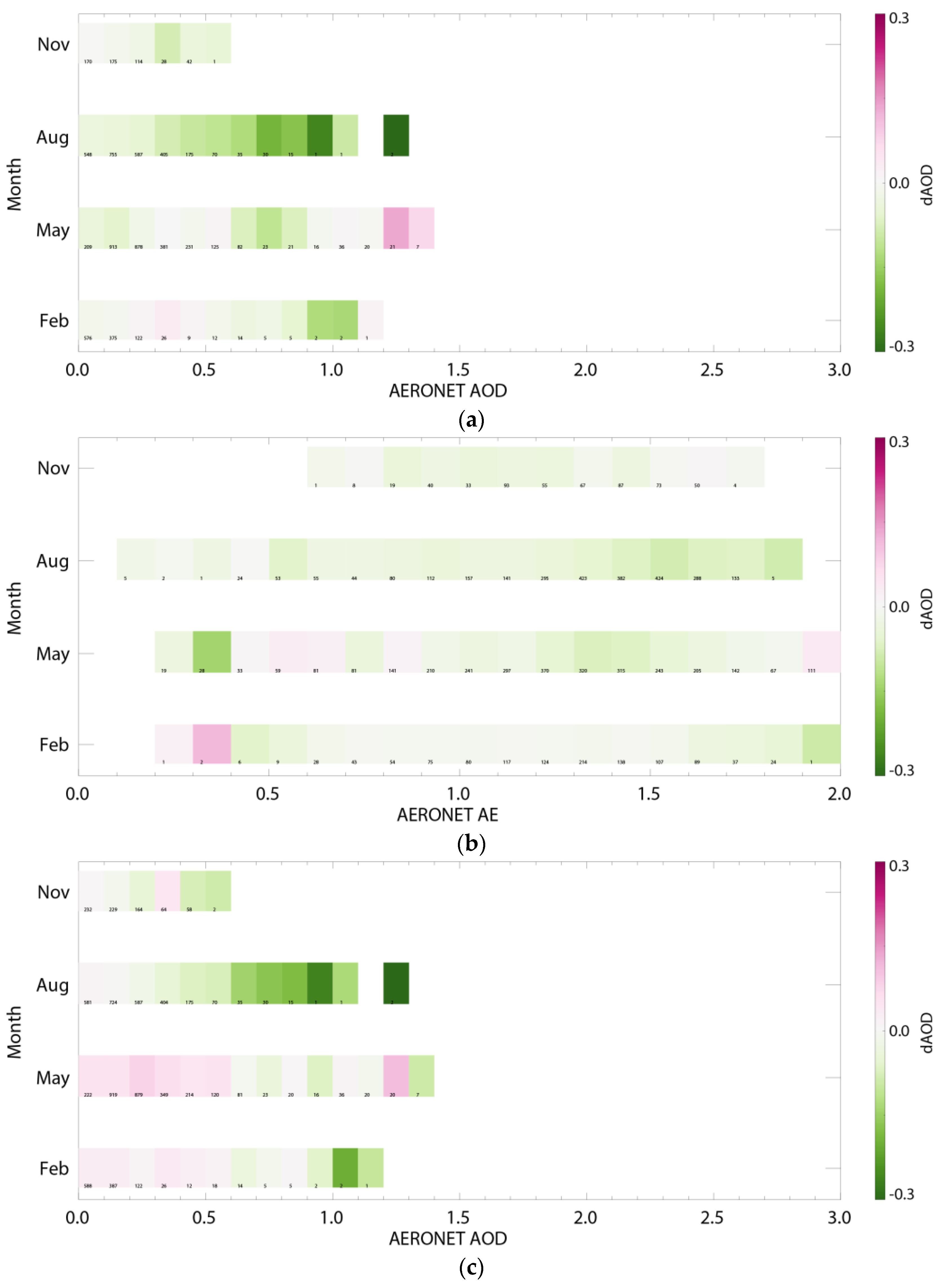
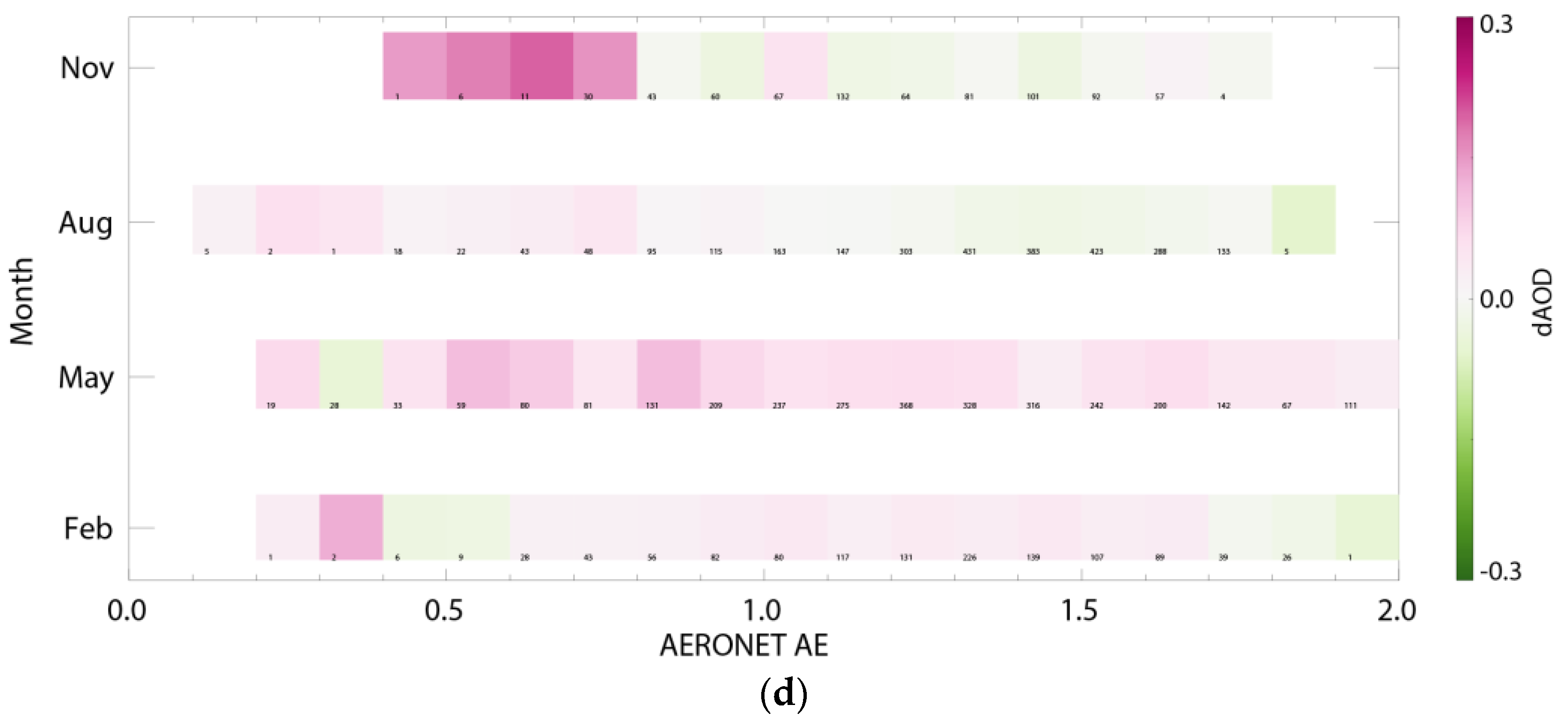
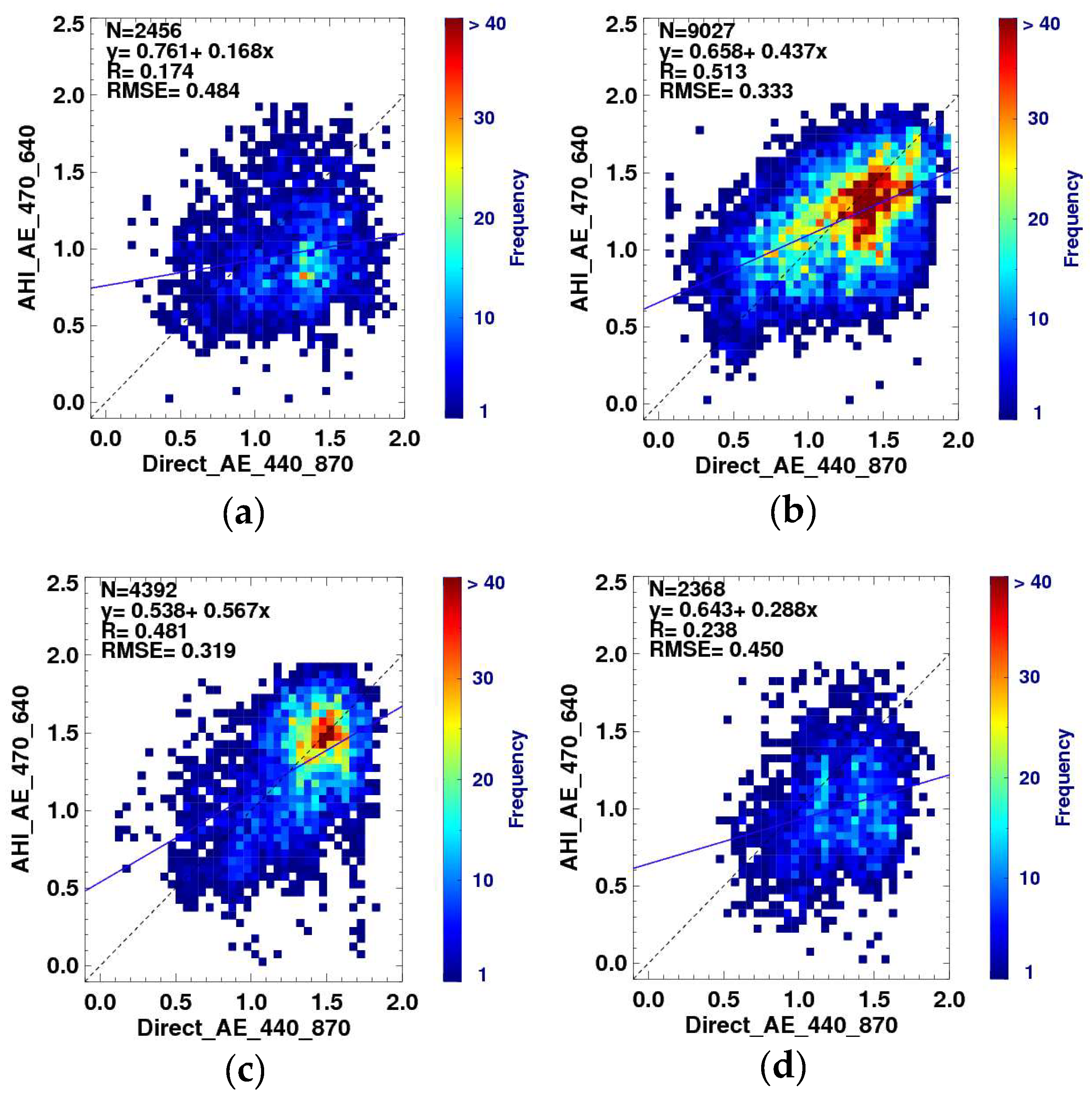
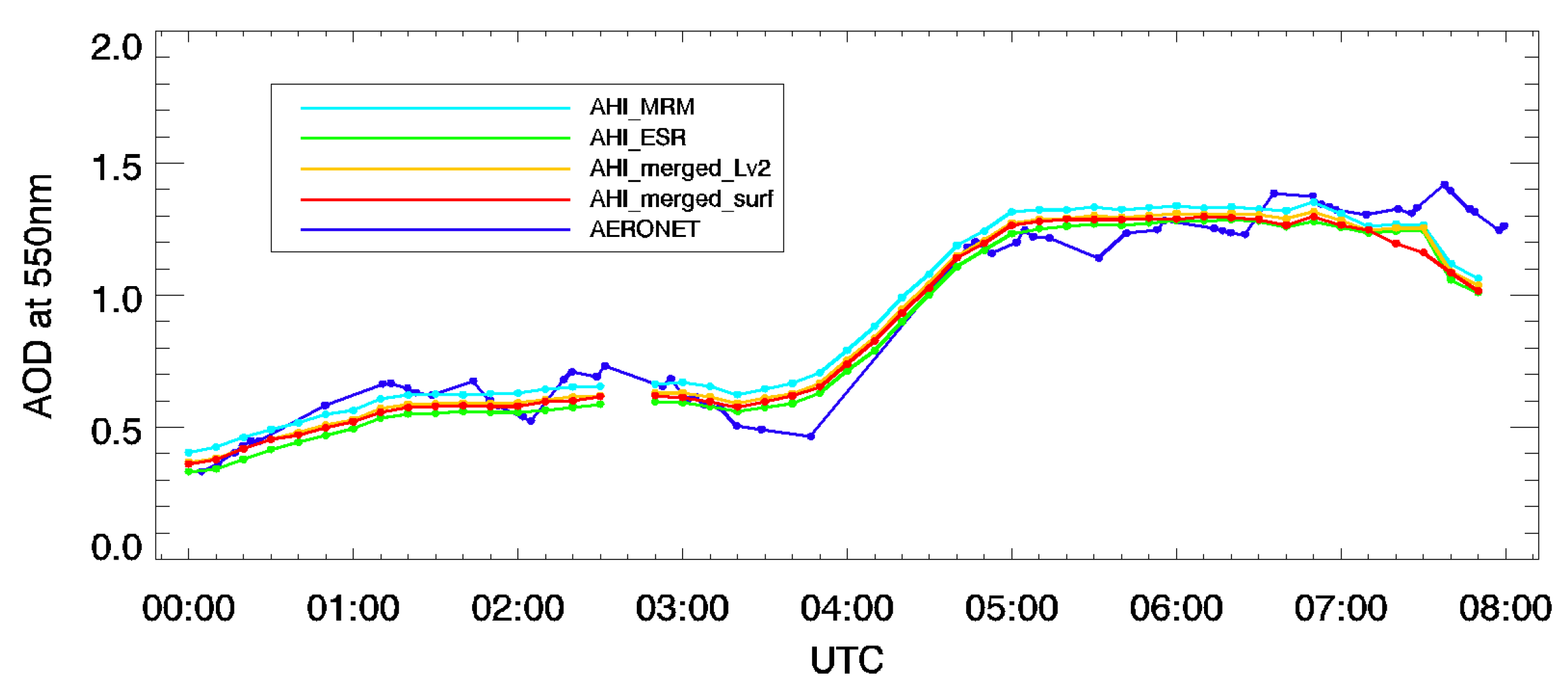
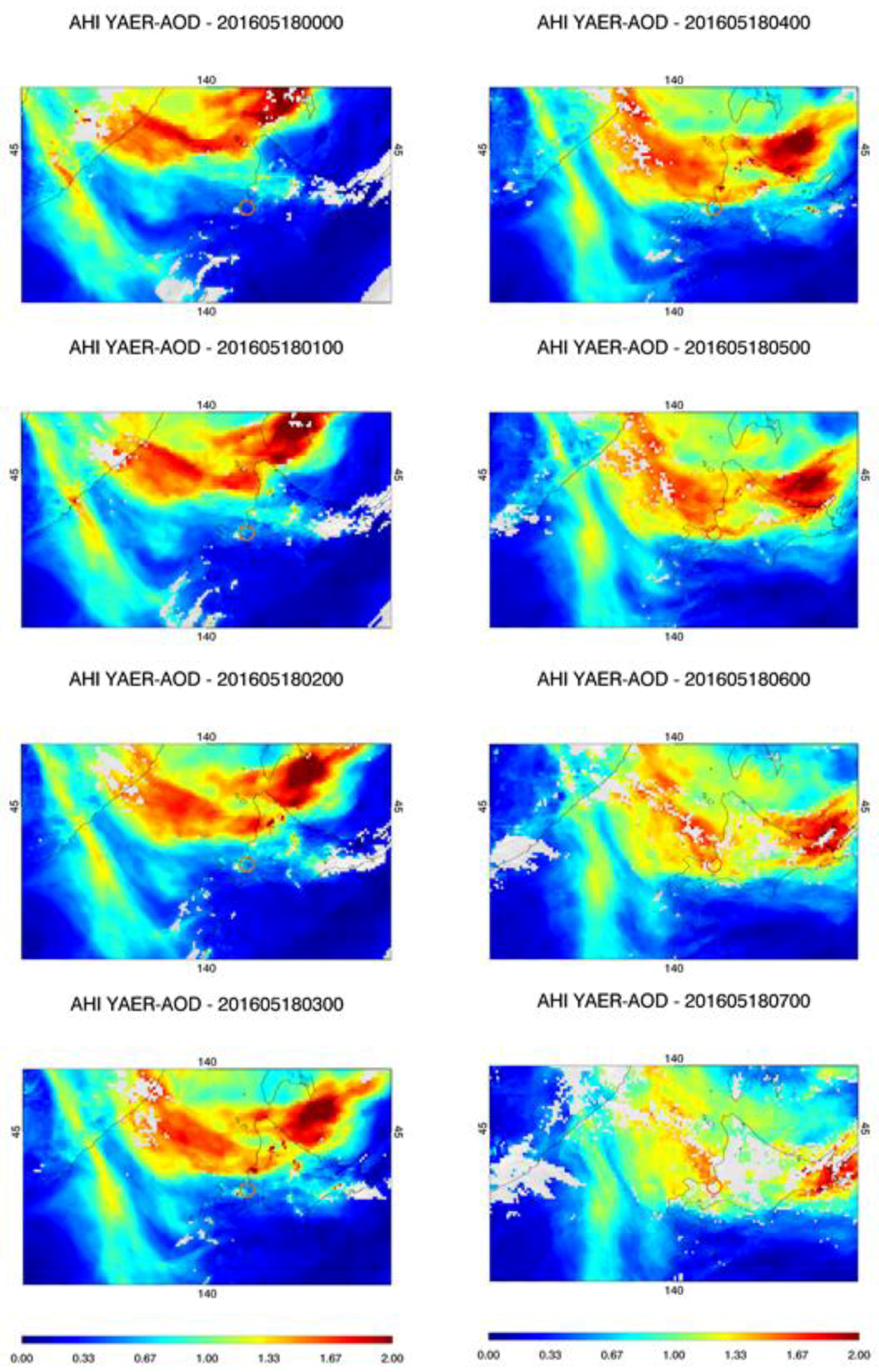
| Band | Center Wavelength (μm) | Spatial Resolution at Sub-Satellite Point (km) |
|---|---|---|
| 1 | 0.470 | 1 |
| 2 | 0.510 | 1 |
| 3 | 0.640 | 0.5 |
| 4 | 0.856 | 1 |
| 5 | 1.61 | 2 |
| 6 | 2.26 | 2 |
| 7 | 3.89 | 2 |
| 8 | 6.24 | 2 |
| 9 | 6.94 | 2 |
| 10 | 7.35 | 2 |
| 11 | 8.56 | 2 |
| 12 | 9.63 | 2 |
| 13 | 10.4 | 2 |
| 14 | 11.2 | 2 |
| 15 | 12.4 | 2 |
| 16 | 13.3 | 2 |
| Step | Condition | Classification |
|---|---|---|
| 1 | BTD between Band 15 and Band16 land and ocean: <11 K | high-level cloud over land and ocean |
| 2 | BTD between Band 11 and Band 9 land and ocean: <−10 K | low-level cloud over land and ocean |
| 3 | BTD between Band 14 and Band 11 land and ocean: <0 K | cirrus cloud over land and ocean |
| 4 | BTD between Band 14 max *, Band 14, Band 9 max * and Band 9; Band 14 max * − Band 14 > 15 K; Band 9 max * − Band 9 > 10 K | cloud over land |
| 5 | BTD between Band 14 and Band 15 high latitude (segment 1 and 10) ocean: <−1.0 K; mid-low latitude (segment from 2 to 9) ocean: <0.5 K | cloud over ocean |
| 6 | STD test at Band 2 and Band 4 > 0.0025 | cloud over ocean |
| 7 | mean-weighted STD test at Band 1 > 0.0025 | cloud over land |
| 8 | pseudo GEMI index at Band 3 and Band 4 < 1.87 | cloud over land |
| 9 | TOA reflectance test at Band 1 > 0.35 | cloud over land and ocean |
| 10 | NDVI (using Band 3 and Band 4) < −0.01 | inland water |
| 11 | relationship between Band 6 > 0.2 and NDVISWIR (using Band 5 and Band 6) < 0.05 | arid area |
| 12 | NDSI (using Band 2 and Band 5) > 0.35 and Band 4 > 0.11 | snow and ice over land |
| 13 | ratio between Band 4 and Band 5 < 0.82 with Band 6 reflectance > 0.25 | cloud over bright land surface |
| 14 | difference between Band 3 and linearly-interpolated Band 3 from Band 1 and Band 6 > −0.03 | high-turbidity pixels masked over ocean |
| 15 | glint angle < 25° | sun glint mask over ocean |
| 16 | Constraint in the number of pixels out of 6 × 6 pixels < 3 | Step 1–15 for 6 × 6 pixels |
| 17 | Band 6 reflectance after aggregation (6 km resolution) | arid area masking |
| Site | Lon.(° E)/Lat.(° N) | Training(Lv1.5)/Validation(Lv2) | Land Type/Average of the Fraction of Land Type within 25 km for Site (%) | Site | Lon.(° E)/Lat.(° N) | Training(Lv1.5) /Validation(Lv2) | Land Type/Average of the Fraction of Land Type within 25 km for Site (%) |
|---|---|---|---|---|---|---|---|
| Anmyon | 126.330/36.539 | T/- | 1 | KORUS_Kyungpook | 128.606/35.890 | T/L2,5,8 | 2/13.8 |
| Baengnyeong | 124.630/37.966 | T/O2,5,8 | 1 | KORUS_Mokpo_NU | 126.437/34.913 | T/L2,5,8, O2,5,8 | 3/41.4 |
| Beijing-CAMS | 116.317/39.933 | T/L2,5,8 | 2/57.1 | KORUS_NIER | 126.640/37.569 | T/L2,5, O5 | 1 |
| Beijing | 116.381/39.977 | T/L2,5 | 2/57.3 | KORUS_Olympic_Park | 127.124/37.522 | T/L5 | 2/39.0 |
| Beijing_RADI | 116.379/40.005 | T/L2 | 2/55.3 | KORUS_Songchon | 127.489/37.338 | T/L5 | 3/35.7 |
| Chiayi | 120.496/23.496 | -/L2 | 1 | KORUS_Taehwa | 127.310/37.312 | T/L5 | 1 |
| Chiba_University | 140.104/36.625 | T/- | 1 | KORUS_UNIST_Ulsan | 129.190/35.582 | T/L5,8,11 | 1 |
| Fukuoka | 130.475/33.524 | T/L2 | 2/20.0 | Niigata | 138.942/37.846 | T/- | 3/29.2 |
| Ganneung_WNU | 128.867/37.771 | T/- | 1 | Noto | 137.137/37.334 | T/- | 1 |
| Gosan_SNU | 126.162/33.292 | T/L5,8, O5,8 | 1 | Osaka | 135.591/34.651 | T/L2,5,8,11, O2,5,8,11 | 1 |
| Gwangju_GIST | 126.843/35.228 | T/L5 | 1 | Pusan_NU | 129.082/35.235 | T/L2,5,8,11, O2,5,8,11 | 2/17.9 |
| Hankuk_UFS | 127.266/37.339 | -/L2,5,8,11 | 1 | Seoul_SNU | 126.951/37.458 | T/- | 2/55.5 |
| Hokkaido_university | 141.341/43.075 | T/L2,5,8, O2,5,8 | 2/13.8 | Shirahama | 135.357/33.693 | T/L2,5, O2,5 | 1 |
| Hong_Kong_Sheung | 114.117/22.483 | -/L2,5, O5 | 1 | Ussuriysk | 132.163/43.700 | T/- | 1 |
| KORUS_Baeksa | 127.567/37.412 | T/L5 | 3/25.4 | XiangHe | 116.962/39.754 | T/- | 3/87.7 |
| KORUS_Daegwallyeong | 128.759/37.687 | T/L5 | 1 | Yonsei_University | 126.935/37.564 | T/L2,5,8,11 | 2/47.5 |
| KORUS_Iksan | 127.005/35.962 | -/L5 | 3/60.0 |
| a1 | b1 | a2 | b2 | |
|---|---|---|---|---|
| All land types (excluding urban and cropland) | −0.705 | 0.515 | −0.073 | 0.028 |
| Urbanization fraction 10–30% | −1.605 | 0.717 | −0.008 | 0.008 |
| Urbanization fraction 30–70% | −1.681 | 0.812 | −0.023 | 0.003 |
| Urbanization fraction > 70% | −1.944 | 0.944 | −0.021 | −0.002 |
| Cropland fraction 10–30% | −1.573 | 0.807 | −0.014 | 0.001 |
| Cropland fraction 30–70% | −1.096 | 0.629 | −0.047 | 0.017 |
| Cropland fraction > 70% | −0.592 | 0.454 | −0.065 | 0.031 |
| a470 | b470 | a510 | b510 | |
|---|---|---|---|---|
| All land types (excluding urban and cropland) | 0.561 | −0.009 | 0.661 | −0.002 |
| Urbanization fraction 10–30% | 0.635 | −0.010 | 0.722 | −0.004 |
| Urbanization fraction 30–70% | 0.643 | −0.013 | 0.724 | −0.004 |
| Urbanization fraction > 70% | 0.637 | −0.011 | 0.735 | −0.003 |
| Cropland fraction 10–30% | 0.645 | −0.013 | 0.736 | −0.005 |
| Cropland fraction 30–70% | 0.652 | −0.015 | 0.738 | −0.006 |
| Cropland fraction > 70% | 0.654 | −0.006 | 0.654 | −0.006 |
| Variable | Value |
|---|---|
| solar zenith angle (°) | 0.01, 10, 20, 30, 40, 50, 60 and 70 |
| viewing zenith angle (°) | 0.01, 10, 20, 30, 40, 50, 60 and 70 |
| relative azimuth angle (°) | 0.01, 10, 20, 30, 40, 50, 60, 70, … 180 |
| AOD–each reference wavelength | 0, 0.25, 0.50, 1.0, 1.5, 2.0 and 3.0 |
| aerosol type | black carbon, non-absorbing, mixture, and dust |
| surface albedo * | 0.0, 0.05, 0.1 and 0.2 |
| terrain height * (km) | 0 and 5 |
| band (4) | 1 (470 nm), 2 (510 nm), 3 (640 nm) and 4 (860 nm) |
| wind speed ** () | 1, 4, 7, 10, 13 and 16 |
| chlorophyll-a concentration ** () | 0.01, 1, 10 and 50 |
| LAND/Average of a Degree of Urban and Cropland within 25 km for Each Site | N | R | RMSE | MBE | %EE | |
|---|---|---|---|---|---|---|
| Beijing (116.381/39.977)/Urban 57.3% | MRM | 351 | 0.979 | 0.081 | −0.017 | 78.9 |
| ESR | 354 | 0.969 | 0.094 | −0.016 | 81.1 | |
| Yonsei_university (126.935/37.564)/Urban 47.5% | MRM | 552 | 0.809 | 0.120 | −0.072 | 45.5 |
| ESR | 552 | 0.856 | 0.086 | 0.033 | 72.8 | |
| KORUS_Iksan (127.005/35.962)/cropland 60.0% | MRM | 500 | 0.900 | 0.118 | −0.042 | 59.8 |
| ESR | 512 | 0.905 | 0.133 | 0.085 | 55.7 | |
| KORUS_Songchon (127.489/37.338)/cropland 35.7% | MRM | 528 | 0.849 | 0.161 | −0.111 | 40.2 |
| ESR | 528 | 0.886 | 0.121 | −0.047 | 74.6 | |
| KORUS_Taehwa (127.310/37.312)/other land type | MRM | 514 | 0.867 | 0.120 | −0.077 | 49.4 |
| ESR | 524 | 0.912 | 0.077 | −0.013 | 86.8 | |
| Shirahama (135.357/33.693)/other land type | MRM | 183 | 0.859 | 0.068 | −0.012 | 77.0 |
| ESR | 181 | 0.920 | 0.069 | −0.057 | 64.1 | |
| Rs Merged/L2 Merged | N | R | RMSE | MBE | %EE |
|---|---|---|---|---|---|
| February | 2624/2624 | 0.727/0.776 | 0.107/0.087 | 0.007/−0.012 | 78.2/83.2 |
| May | 9086/9064 | 0.905/0.906 | 0.096/0.103 | 0.01/−0.039 | 76.3/68.3 |
| August | 4468/4419 | 0.840/0.838 | 0.131/0.129 | 0.03/−0.017 | 65.2/63.7 |
| November | 2486/2466 | 0.809/0.78 | 0.086/0.089 | −0.011/−0.016 | 75.9/71.2 |
© 2018 by the authors. Licensee MDPI, Basel, Switzerland. This article is an open access article distributed under the terms and conditions of the Creative Commons Attribution (CC BY) license (http://creativecommons.org/licenses/by/4.0/).
Share and Cite
Lim, H.; Choi, M.; Kim, J.; Kasai, Y.; Chan, P.W. AHI/Himawari-8 Yonsei Aerosol Retrieval (YAER): Algorithm, Validation and Merged Products. Remote Sens. 2018, 10, 699. https://doi.org/10.3390/rs10050699
Lim H, Choi M, Kim J, Kasai Y, Chan PW. AHI/Himawari-8 Yonsei Aerosol Retrieval (YAER): Algorithm, Validation and Merged Products. Remote Sensing. 2018; 10(5):699. https://doi.org/10.3390/rs10050699
Chicago/Turabian StyleLim, Hyunkwang, Myungje Choi, Jhoon Kim, Yasuko Kasai, and Pak Wai Chan. 2018. "AHI/Himawari-8 Yonsei Aerosol Retrieval (YAER): Algorithm, Validation and Merged Products" Remote Sensing 10, no. 5: 699. https://doi.org/10.3390/rs10050699
APA StyleLim, H., Choi, M., Kim, J., Kasai, Y., & Chan, P. W. (2018). AHI/Himawari-8 Yonsei Aerosol Retrieval (YAER): Algorithm, Validation and Merged Products. Remote Sensing, 10(5), 699. https://doi.org/10.3390/rs10050699






